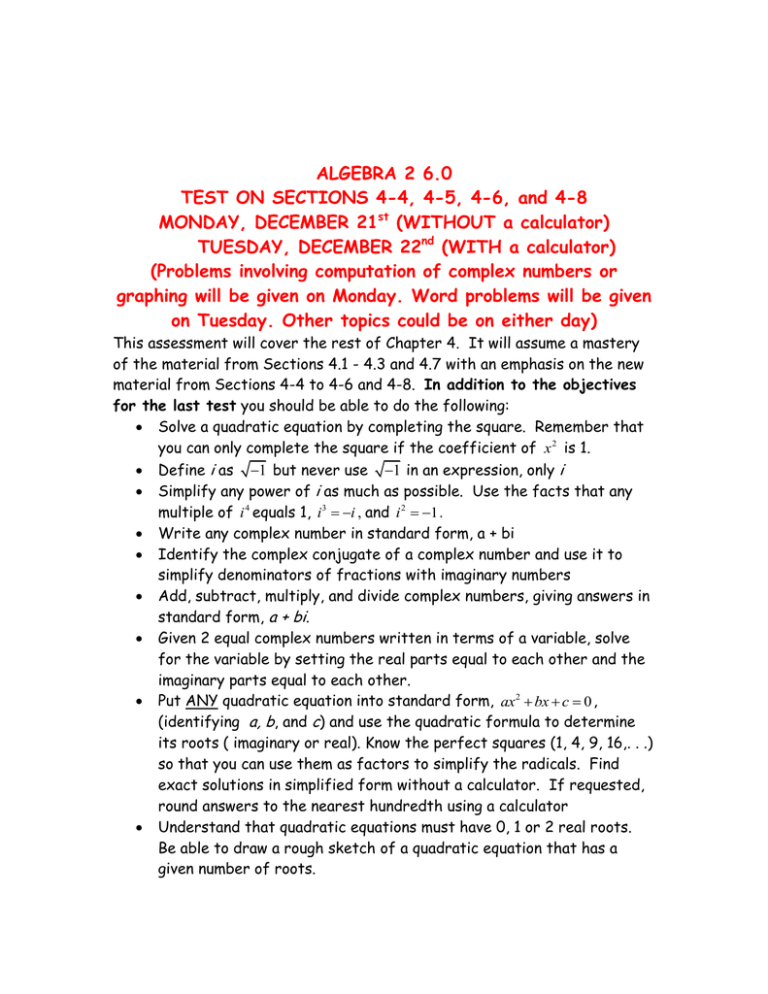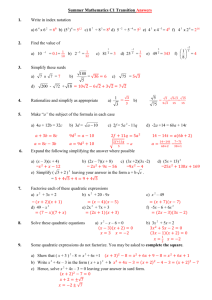ALGEBRA 2 6.0 TEST ON SECTIONS 4-4, 4-5, 4-6, and 4-8
advertisement

ALGEBRA 2 6.0 TEST ON SECTIONS 4-4, 4-5, 4-6, and 4-8 MONDAY, DECEMBER 21st (WITHOUT a calculator) TUESDAY, DECEMBER 22nd (WITH a calculator) (Problems involving computation of complex numbers or graphing will be given on Monday. Word problems will be given on Tuesday. Other topics could be on either day) This assessment will cover the rest of Chapter 4. It will assume a mastery of the material from Sections 4.1 - 4.3 and 4.7 with an emphasis on the new material from Sections 4-4 to 4-6 and 4-8. In addition to the objectives for the last test you should be able to do the following: Solve a quadratic equation by completing the square. Remember that you can only complete the square if the coefficient of x 2 is 1. Define i as 1 but never use 1 in an expression, only i Simplify any power of i as much as possible. Use the facts that any multiple of i 4 equals 1, i3 i , and i 2 1 . Write any complex number in standard form, a + bi Identify the complex conjugate of a complex number and use it to simplify denominators of fractions with imaginary numbers Add, subtract, multiply, and divide complex numbers, giving answers in standard form, a + bi. Given 2 equal complex numbers written in terms of a variable, solve for the variable by setting the real parts equal to each other and the imaginary parts equal to each other. Put ANY quadratic equation into standard form, ax2 bx c 0 , (identifying a, b, and c) and use the quadratic formula to determine its roots ( imaginary or real). Know the perfect squares (1, 4, 9, 16,. . .) so that you can use them as factors to simplify the radicals. Find exact solutions in simplified form without a calculator. If requested, round answers to the nearest hundredth using a calculator Understand that quadratic equations must have 0, 1 or 2 real roots. Be able to draw a rough sketch of a quadratic equation that has a given number of roots. Given two root(s) (real or imaginary) determine a quadratic equation that has those roots. Determine the discriminant of a quadratic equation and use it to describe the roots (number of roots, real, imaginary, rational, irrational. Remember - only real numbers are rational or irrational) Solve quadratic inequalities in one variable both algebraically and graphically. Algebraic solutions require a chart. Graphic solutions require a rough sketch of a parabola. Graph the solution of a quadratic inequality in two variables. Remember that the solution is a set of ordered pairs represented by the shaded region. Have a clear understanding of the difference between inequalities of the form y < ax2 + bx + c (solution is a set of ordered pairs and must be graphed) and 0 < ax2 + bx + c (solution is a set of real numbers and can be described using interval notation). Use your knowledge of quadratic functions to solve word problems involving concepts such as, but not limited to, objects thrown or launched into the air or dropped from above, maximum or minimum values for area, profit, revenue, or cost. For each problem be able to define the variable(s) and write the equation or inequality to be used to solve the problem, You may use any method to solve the equation or inequality. Depending on the directions, you must show your work or describe briefly what you did on the calculator (i.e, found the xintercepts, found the maximum value from the vertex, found the intersection of the two graphs.)




